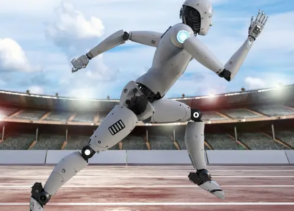
China is organizing an innovative race described as a “world’s first” — a half-marathon where humans will go head-to-head with their own creation: humanoid robots.
According to a report, the marathon is scheduled for April in Beijing’s Daxing District. Robots created by tech companies from around the globe will join 12,000 human runners, marking the first time such machines will complete the full race distance this year. This unique competition highlights China’s determined efforts to lead in AI and robotics technology. The 21km (13-mile) course will challenge both humans and robots, with prizes awarded to the top three performers.
Robot Requirements
The Beijing Economic-Technological Development Area stated that global participants — including companies, research institutions, robotics clubs, and universities worldwide — must design robots that:
① Have human-like physical features.
② Use advanced mechanics enabling bipedal (双足行走的) movement (walking/running without wheels).
③ Stand between 0.5-2 meters tall.
④ Operate via remote control or full autonomy. Battery changes during the race are allowed.
Global Robotic Progress
Countries like South Korea have also been actively advancing their robotic creations. Last year, the KAIST-developed robot RAIBO2 finished a full marathon (26.2 miles) in just over 4 hours on a single battery charge, demonstrating significant progress in robotic endurance.
In China, robots are increasingly used in races. Last year, the humanoid robot “Tiangong” served as “closing pacer” to encourage runners near the finish line at a Beijing half-marathon. Another robot cheered runners post-race and even performed a short run in another event.
Strategic Importance
China views humanoid robotics as a key industry for economic development and technological independence, partly driven by technological competition with the United States. Robots are also expected to help address China’s critical challenges: an aging population and a declining workforce. On the other hand, China is increasingly relying on robots to provide support for the elderly. This includes deploying (部署) robots in caregiving roles to provide emotional support, monitor health, and offer smart home assistance to the elderly.
原创编写 版权所有 侵权必究! 每日更新 个性化阅读 英语飙升!
1.1. What is a unique feature of the half-marathon mentioned in the text?
A It will feature both human runners and humanoid robots competing together.
B It is the first half-marathon to be held in Beijing.
C The race is only open to robots designed by Chinese companies.
D The race is designed to promote tourism in Daxing District.
解析:选A。细节理解题。根据第一段的“a half-marathon where humans will go head-to-head with their own creation: humanoid robots”和第二段的“marking the first time such machines will complete the full race distance this year”可知,在这场半程马拉松中,人类将与人形机器人同场竞技。故选A。
2.2. Which requirement is NOT mentioned for participating robots?
A Robots must possess a human-like appearance.
B Robots must use wheels for movement.
C Robots must be between 0.5 and 2 meters tall.
D Robots can operate either remotely or autonomously.
解析:选B。细节理解题。根据文章中的“Robot Requirements”部分可知,参赛机器人须具备人形外观和可实现双足行走或奔跑等动作的机械结构,不包括轮式结构。其全尺寸组身高在0.5米到2米之间,可以采取手动遥控(包含半自动)或完全自主方式控制,比赛过程中可更换电池。故选B。
3.3. What can be inferred about the robot RAIBO2 from the text?
A It was developed by a Chinese research team.
B It served as a pacer in a Beijing marathon.
C It focused on providing elderly care services.
D It demonstrated improved battery endurance.
解析:选D。细节理解题。根据文章中“Global Robotic Progress”部分的“the KAIST-developed robot RAIBO2 finished a full marathon (26.2 miles) in just over 4 hours on a single battery charge, demonstrating significant progress in robotic endurance”可知,RAIBO2单次充电后,以4小时多一点的成绩完成全程马拉松(42.195公里),展现出机器人续航能力的重大突破。故选D。
4.4. Why does China view humanoid robotics as a key industry?
A To improve international image through entertainment events.
B To satisfy public interest in advanced technologies.
C To address economic competition and domestic social issues.
D To replace human workers in manufacturing completely.
解析:选C。推理判断题。最后一段指出中国发展机器人既是出于“technological competition with the United States”(经济竞争),也为应对“aging population and declining workforce”(社会问题)。故选C。